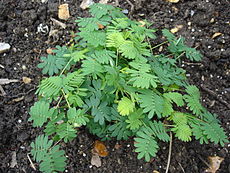
Back إدراك النبات Arabic Pflanzenneurobiologie German Planta percepto Esperanto Percepción vegetal Spanish Perception par les plantes French Neurobiologia vegetale Italian 植物の知覚 Japanese Neurobiologia roślin Polish தாவர அறிவு Tamil การตอบสนองของพืช Thai
The leaf closing after touch in Mimosa pudica depends on electrical signals
Plant perception is the ability of plants to sense and respond to the environment by adjusting their morphology and physiology.[1] Botanical research has revealed that plants are capable of reacting to a broad range of stimuli, including chemicals, gravity, light, moisture, infections, temperature, oxygen and carbon dioxide concentrations, parasite infestation, disease, physical disruption, sound,[2][3][4][5] and touch. The scientific study of plant perception is informed by numerous disciplines, such as plant physiology, ecology, and molecular biology.
- ^ Trewavas A (September 2005). "Green plants as intelligent organisms". Trends in Plant Science. 10 (9): 413–9. doi:10.1016/j.tplants.2005.07.005. PMID 16054860.
- ^ Gagliano M, Mancuso S, Robert D (June 2012). "Towards understanding plant bioacoustics". Trends in Plant Science. 17 (6): 323–5. doi:10.1016/j.tplants.2012.03.002. PMID 22445066.
- ^ Gagliano M (July 2013). "Green symphonies: a call for studies on acoustic communication in plants". Behavioral Ecology. 24 (4): 789–796. doi:10.1093/beheco/ars206. PMC 3677178. PMID 23754865.
- ^ Gagliano M, Grimonprez M, Depczynski M, Renton M (May 2017). "Tuned in: plant roots use sound to locate water". Oecologia. 184 (1): 151–160. Bibcode:2017Oecol.184..151G. doi:10.1007/s00442-017-3862-z. PMID 28382479. S2CID 5231736.
- ^ Mishra RC, Ghosh R, Bae H (August 2016). "Plant acoustics: in the search of a sound mechanism for sound signaling in plants". Journal of Experimental Botany. 67 (15): 4483–94. doi:10.1093/jxb/erw235. PMID 27342223.
© MMXXIII Rich X Search. We shall prevail. All rights reserved. Rich X Search

